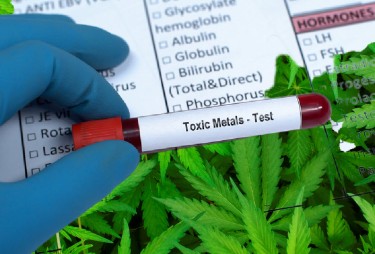
In recent years, the growing acceptance and legalization of marijuana for recreational and medicinal use have spurred extensive research into its effects on health and well-being. Amid this evolving landscape, a noteworthy study has surfaced, shedding light on a pressing concern: heavy metal contamination in marijuana. This study, conducted by a dedicated team at Columbia University, has revealed unsettling data indicating that certain marijuana users may unwittingly expose themselves to heightened levels of heavy metals, specifically lead and cadmium, substances associated with profound and enduring health risks.
These results have broad repercussions because they force us to address a complex web of problems related to marijuana legalization safety, and use. Given that cannabis plants have the unique ability to absorb these pollutants from the soil in which they are grown, heavy metals, infamous for their harmful effects on human health, present a daunting barrier. Examining any hidden problems that might exist within this developing industry becomes more and more important as marijuana use spreads throughout numerous jurisdictions.
Study Methodology: A Closer Look at Blood and Urine
The study drew upon data from 2005 to 2018, sourced from the annual National Health and Nutrition Examination Survey (NHANES), a comprehensive health assessment of the American population. This survey serves as a vital tracking tool for monitoring the well-being of U.S. citizens.
Within this study, the researchers scrutinized blood and urine samples from 7,254 individuals who self-reported recent marijuana use (within the past 30 days). What sets this investigation apart is its distinctive focus on the heavy metal levels within these individuals rather than solely assessing heavy metal concentrations within cannabis plants, as is more common in related studies. According to Tiffany Sanchez, one of the study's authors, this aspect renders the research unique. However, it's essential to acknowledge that the study did not distinguish between individuals using marijuana for medical or recreational purposes, preventing definitive conclusions regarding metal levels among medical cannabis users. Sanchez emphasized the importance of further exploration in future research endeavors.
Heavy metals can adhere to body cells and obstruct their ability to operate normally. This phenomenon has a long history and has been linked to serious health issues like cancer, degenerative disorders, and neurotoxic consequences. Additionally, some segments of the population, such as those immunocompromised or undergoing chemotherapy, may be at higher risk of exposure to metals or other common pollutants found in cannabis, such as molds. It's important to note that this area still needs more study and attention because it is still poorly understood.
It's critical to understand that other people are also exposed to heavy metals; tobacco users, for example, are exposed to an even wider range of pollutants. Notably, it has been discovered that e-cigarettes contain high levels of metal aerosols such as nickel, chromium, lead, and zinc. Studies have also shown that e-liquids and the tanks of e-cigarettes include arsenic, lead, nickel, tin, manganese, copper, and chromium, further highlighting the complexity of problems related to substance abuse and significant health dangers.
Regulation and Safeguarding Against Heavy Metal Contamination
The issue of heavy metal contamination in marijuana products is further compounded by the fragmented legal landscape surrounding cannabis in the United States. With marijuana being illegal at the federal level but legal for recreational use in 22 states and permitted for medicinal use in 38 states, there exists a complex web of regulations and standards—or lack thereof.
In some states where marijuana is legal, regulations mandate testing for heavy metals, and strict limits are set on their concentrations in cannabis products. However, each state tends to establish its permissible levels of contaminants, leading to inconsistencies in safety standards.
Furthermore, illegal dispensaries in states where marijuana is legalized pose a significant challenge. These unregulated outlets often sell products that may not undergo rigorous testing for heavy metal contamination. Consumers may unknowingly purchase marijuana products with elevated levels of heavy metals from these unregulated sources.
Even hemp-derived products, which have gained popularity, lack consistent federal testing rules for heavy metals. Recent research has revealed heavy metal contamination in products like hemp-derived CBD e-cigarettes.
Despite these challenges, there are positive developments. States are progressively improving their screening processes for contaminants in marijuana products. Notably, the study cited includes data from before many states had fully legalized marijuana, suggesting that the situation might be evolving.
To safeguard against heavy metal contamination in marijuana products, consumers are encouraged to purchase from legal dispensaries, as these establishments typically adhere to state-mandated testing and quality control standards. State health department websites often provide lists of licensed dispensaries. Additionally, consumers should request certificates of analysis from dispensaries, ensuring that products meet safety standards and are free from heavy metal contaminants. Continued efforts to establish consistent, nationwide regulations and standards for heavy metal testing in marijuana and hemp-derived products are crucial for ensuring public safety and health.
Sources and Consequences of Heavy Metal Contamination in Marijuana
Heavy metal contamination in marijuana primarily originates from the plant's remarkable capacity to absorb these harmful substances from its environment. Soil contamination is a key source, as the cannabis plant absorbs heavy metals naturally in the soil when it draws nutrients and water. Environmental factors, such as industrial emissions and water pollution, can also introduce heavy metals into the plant's growth cycle. Furthermore, unregulated cultivation practices, particularly in regions where marijuana remains illegal or unmonitored, can lead to contaminated soil, water, and fertilizers, increasing the risk of heavy metal contamination in the final product.
The effects of marijuana containing heavy metals are significant and wide-ranging. Significant health concerns are posed to consumers by this pollution. When children are exposed to lead, even a small amount of it can negatively affect their cognitive development, and adults exposed to lead are more likely to develop high blood pressure, heart difficulties, and kidney damage. A carcinogen classified as cadmium can weaken bones and cause kidney illness. The effects of persistent exposure to these heavy metals may severely and permanently impact an individual's general well-being.
Furthermore, heavy metal contamination in marijuana is not just a personal concern; it also extends to public health. With the increasing legalization of marijuana, the risk of encountering contaminated products rises. Medicinal marijuana users may be particularly vulnerable, often with preexisting health conditions. The lack of consistent regulations and testing standards across states and nations complicates the issue, making it challenging for consumers to assess product safety. Environmental concerns arise as improper disposal of contaminated plant material or cultivation waste can lead to soil and water pollution, endangering ecosystems and potentially affecting other crops and wildlife. Addressing this problem requires the implementation of stringent regulations, standardized testing procedures, and enhanced consumer awareness to ensure the safety of marijuana products while safeguarding public health and the environment.
Bottom Line
The study reveals a concerning link between marijuana use and heavy metal exposure, particularly lead and cadmium, highlighting potential health risks. With inconsistent regulations and safety standards across states, consumers should seek products from legal dispensaries and demand certificates of analysis to ensure safety. Addressing this issue requires stringent regulations and enhanced awareness to safeguard public health and the environment.
HEAVY METALS IN YOUR WEED? READ ON...
HEMP CLEANS HEAVY METALS FROM SOIL, BUT DOES IT END UP IN YOUR STASH?






